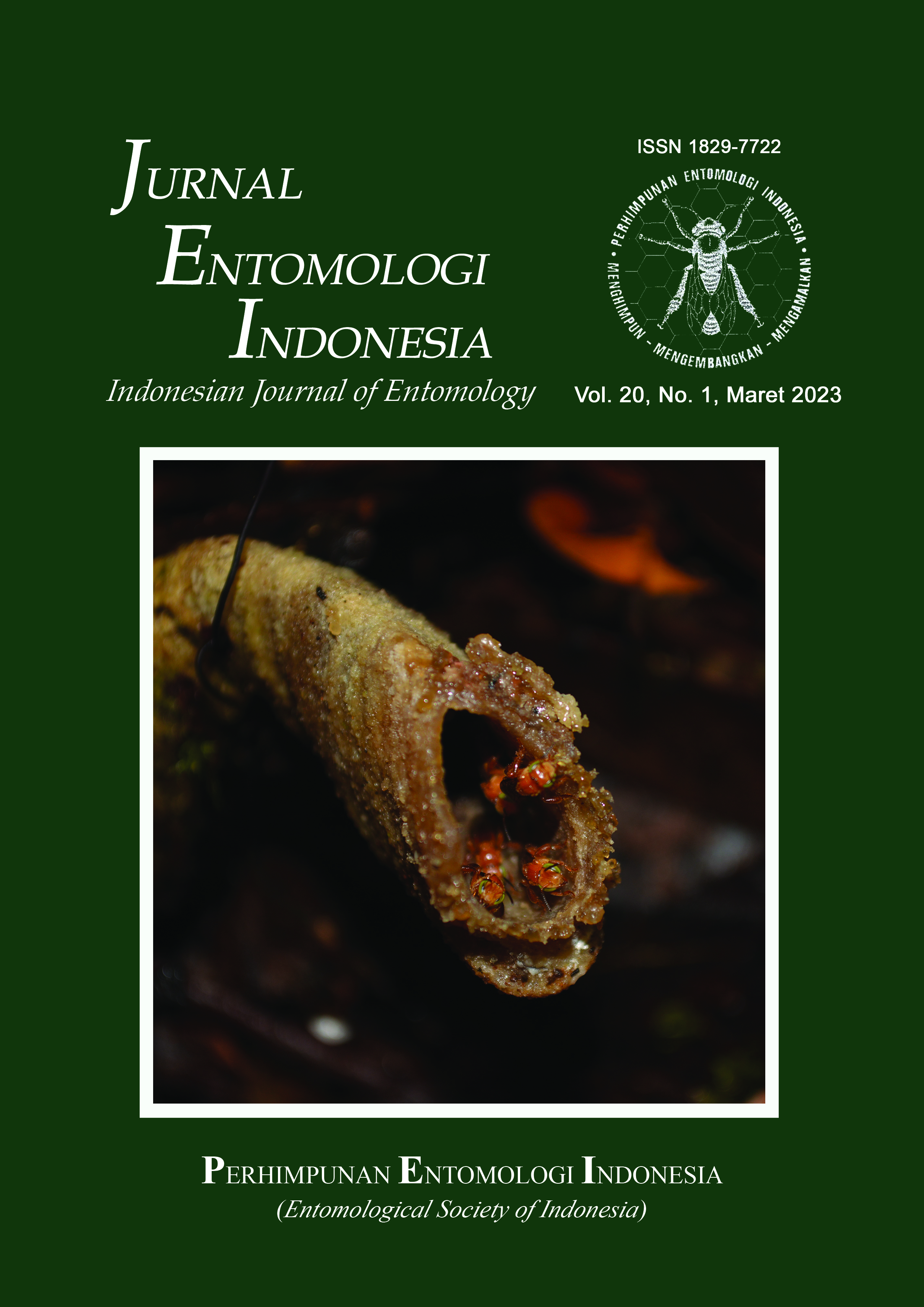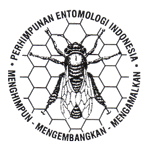Evaluasi efektivitas tanaman repelen dalam pengendalian penggerek batang Apomecyna saltator F. (Coleoptera: Cerambycidae) pada tanaman labu madu dengan pola tanam tumpang sari
Evaluation of the effectiveness of repellent plants in controlling stem borers Apomecyna saltator F. (Coleoptera: Cerambycidae) on honey pumpkin plants with intercropping patterns
DOI:
https://doi.org/10.5994/jei.20.1.57Keywords:
Apomecyna saltator, bio-repellent, technical cultureAbstract
Apomecyna saltator Fabricius (Coleoptera: Cerambycidae) is a pest of honey pumpkin plants whose presence is increasingly more economically important. However, information about this pest is still very limited. Control by application of intercropping patterns has prospects and needs to be developed further. Control of this pest should be an integral part of the development of integrated pest management. This research was conducted to determine the effect of intercropping pattern of honey pumpkin plants with several repellent plants on percentage of infestation, population of A. saltator larvae/pupae, and honey pumpkin production. This study was designed with a randomized block design (RBD) consisting of 4 treatments, namely: honey pumpkin plants monoculture (A); intercropping of honey pumpkin and lemon grass plants (B); intercropping of honey pumpkin and turmeric plants (C); intercropping of honey pumpkin and spring onion plants (D). Each treatment was repeated 6 times. The results show that; the average percentage of infestation by A. saltator until 56 days after planting (DAP) for all treatments ranged from 72–79.6%. The population of A. saltator larvae/pupae ranged from 107–128 individuals/9 plants. Honey pumpkin production ranged from 21.97–26.75 kg/9 plants. From the results it was concluded that turmeric, lemon grass, and spring onions had no effect on the percentage of infestation of A. saltator populations, and honey pumpkin production.
Downloads
References
Anwar K, Juliawati, Puryani I. 2021. Respon pertumbuhan dan hasil tanaman jagung manis pada sistem tumpang sari dengan kacang tanah dan jarak tanam. Jurnal Sains dan Aplikasi. 9:23–30.
Astuti W, Widyastuti CR. 2016. Pestisida organik ramah lingkungan pembasmi hama tanaman sayur. Jurnal Penerapan Teknologi dan Pembelajaran. 14:115–120.
Damayanti TA, Pebriyeni L. 2015. Tanaman penghalang dan ekstrak daun pagoda untuk mengendalikan Bean common mosaic virus pada kacang panjang di Lapangan. Jurnal Hortikultura. 25:238–245. DOI: https://doi.org/10.21082/jhort.v25n3.2015.p238-245.
Debboun M, Frences SP, Strickman DA. 2015. Insect Repellent Handbook. Second Edition. Baco Raton: Taylor & Francis Group.
[Dirjenhorti] Direktorat Jendral Hortikultura. 2019. Standar Operasional Prosedur Budidaya Kunyit Karanganyar. Jakarta: Kementrian Pertanian, Direktorat Jendral Hortikultura.
Fahri, Atmowidi T, Fahri WAN. 2016. Diversity and abundance of cerambycid beetles in the four major land-use types found in Jambi Province, Indonesia. Hayati Journal of Biosciences. 23:56–61. DOI: https://doi.org/10.1016/j.hjb.2016.06.001.
Hasyim A, Setiawati W, Murtiningsih R. 2010. Efikasi dan persistensi minyak serai wangi sebagai biopestisida terhadap Helicoverpa armigera Hubner (Lepidoptera: Noctuide). Jurnal Hortikultura. 20:377–86.
Inayati A,Marwoto M. 2015. Kultur teknis sebagai dasar pengendalian hama kutu kebul Bemisia tabaci Genn. pada tanaman kedelai. Buletin Palawija. 29:14–25.
Junita D, Setiawan B, Anwar F, Muhandri T. 2017. Komponen gizi, aktivitas antioksidan dan karakteristik sensori bubuk fungsional labu kuning (Cucurbita moschata) dan tempe. Jurnal Gizi Pangan. 12:109–116.
Kariyanna B, Gupta R, Bakthavatchalam N, Mohan M, Nithish A, Dinkar NK. 2017c. Host plants record and distribution status of agriculturally important longhorn beetles (Coleoptera: Cerambycidae) from India. Progressive Research – An International Journal. 12:1195–1199.
Kariyanna B, Mohan M, Gupta R. 2017b. Biology, ecology and significance of longhorn beetles (Coleoptera: Cermbycidae). Journal of Entomology and Zoology Studies. 5:1207–1212.
Kariyanna B, Mohan M, Gupta R, Vitali F. 2017a. The checklist of longhorn beetles (Coleoptera: Cerambycidae). India Zootaxa. 4345:1–317. DOI: https://doi.org/10.11646/zootaxa.4345.1.1.
Khan MMH. 2012. Morphometrics of cucurbit longicorn (Apomecyna saltator F.) Coleoptera: Cerambycidae reared on cucurbit vines. Bangladesh Journal of Agricultural Research. 37:543–546. DOI: https://doi.org/10.3329/bjar.v37i3.12131.
Listyana NH, Rahmanda M. 2021. Perbandingan pola tanam monokultur dan tumpangsari pada tanaman tempuyung (Sonchus arvensis L.). Seminar Nasional Dies Natalis UNS. 5:276–284.
Nasution AM. 2020. Pengaruh Tumpang sari terhadap Pertumbuhan dan Produksi Sorgum (Sorghum bicolor (L.) Moench), Jagung (Zea mays (L.) dan Kedelai (Glicyne max (L.) Merril). Skripsi. Medan: Universitas Sumatra Utara.
Nurjanah H, Setiawan B, Roosita K. 2020. Potensi labu kuning (Cucurbita moschata) sebagai makanan tinggi serat dalam bentuk cair. Indonesian Journal of Human Nutrition. 7:54–68. DOI: https://doi.org/10.21776/ub.ijhn.2020.007.01.6.
Purba RP, Bakti D, Sitepu SF. 2015. Hubungan presentase serangan dengan estimasi kehilangan hasil akibat serangan hama penggerek buah kopi Hypothenemus hampei Ferr. (Coleoptera: Scolytidae) di Kabupaten Simalungun. Jurnal Online Agroekoteknologi. 3:790–799.
Rizka N, Rohman F, Suhadi. 2015. Kajian Jenis Lama dan Efektivitas Pola Tanam Tanaman Repellent terhadap Penurunan Kepadatan Populasi Hama Penting pada Tanaman Brokoli (Brassica oleraceaI L. Var Italica). Karya Ilmiah. Malang: Universitas Negeri Malang.
Rustam R, Fauzan H, Andika R. 2018. Uji konsentrasi ekstrak murni rimpang jahe merah (Zingiber officianale Rubrum) terhadap mortalitas ulat grayak (Spodoptera litura F.) pada tanaman kedelai (Glicyne max (L.) Merril). Journal Agrotek Tropika. 7:42–49.
Siregar TM, Eveline E, Jaya FA. 2015. Kajian aktivitas dan stabilitas antioksidan ekstrak kasar bawang daun (Allium fistulosum L.). Prosiding Seminar Nasional Sain dan Teknologi. 1:36–43.
Thaury FRS. 2021. Evaluasi Serangan Penggerek Batang (Apomecyna saltator Fabricius.) Coleoptera: Cerambycidae pada Tanaman Labu Madu (Cucurbita moschata Dusch.). Skripsi. Jambi: Universitas Jambi.
Thaury FRS, Wilyus, Novalina N. 2023. The importance of stem borer, Apomecyna saltator Fabricius (Coleoptera: Cerambycidae) in honey pumpkin plants (Cucurbita moschata Dusch). Journal of Applied Agricultural Science and Technology. 7:53–63.
Waldi MR. 2020. Potensi Berbagai Bumbu Dapur Sebagai Repelen Alami Bagi Kecoa Amerika (Periplaneta americana). Skripsi. Lampung: Universitas Islam Negeri Raden Intan Lampung.
Warman GR, Kristiana R. 2018. Mengkaji sistem tanam tumpang sari tanaman semusim. Proceeding Biology Education Conference. 15:791–794.
Warsana. 2009. Introduksi teknologi tumpang sari jagung dan kacang tanah. Tabloid Sinar Tani. Available at: http://www.litbang.pertanian.go.id/artikel/234/pdf. [accessed December 2022].
Wilyus, Novalina. 2019. Aplikasi Semut Rangrang (Oecophylla smaragdina Fabricius) sebagai Agensia Pengendalian Hayati Hama pada Tanaman Labu Kuning (Cucurbita moschata Duch). Laporan Akhir Penelitian Fakultas Pertanian. Jambi: Universitas Jambi.
Wong JCH. 2016. Host Plant Associations and Chemical Ecology of Cerambycidae. Disesrtation. Urbana, Illinois: University of Illinois at Urbana-Champaign.
Downloads
Published
How to Cite
Issue
Section
License
Copyright (c) 2023 Fitria Salsabilla, Wilyus, Hamdan Maruli Siregar

This work is licensed under a Creative Commons Attribution 4.0 International License.
Authors who publish with this journal agree to the following terms:
- Authors retain copyright and grant the journal right of first publication with the work simultaneously licensed under a Creative Commons Attribution 4.0 International License that allows others to share the work with an acknowledgement of the work's authorship and initial publication in this journal.
- Authors are able to enter into separate, additional contractual arrangements for the non-exclusive distribution of the journal's published version of the work (e.g., post it to an institutional repository or publish it in a book), with an acknowledgement of its initial publication in this journal.
- Authors are permitted and encouraged to post their work online (e.g., in institutional repositories or on their website) prior to and during the submission process, as it can lead to productive exchanges, as well as earlier and greater citation of published work (See The Effect of Open Access).








